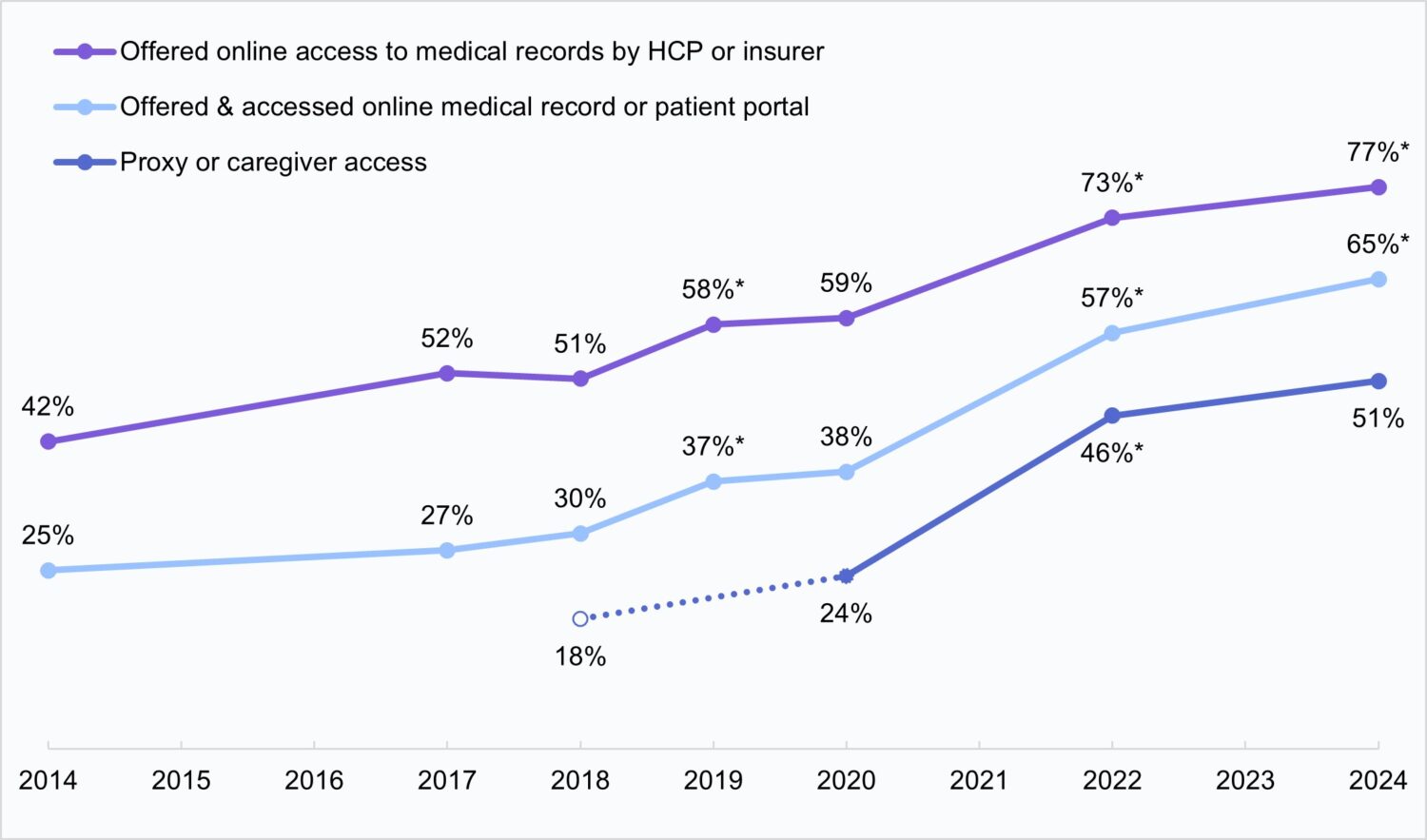
What You Should Know:
– A new brief utilizing the latest 2024 Health Information National Trends Survey (HINTS) data reveals significant progress in patient and caregiver access to online medical records and patient portals.
– Following the implementation of the Cures Act Final Rule provisions and increased demand for virtual care spurred by the COVID-19 pandemic, national access rates have more than doubled in the past decade, with apps playing an increasingly vital role.
Ensuring Access to Health Records for Patients
Empowering patients with secure, convenient access to their health records remains a top federal priority. The 2020 Cures Act Final Rule, published by the Office of the Assistant Secretary for Technology Policy (ASTP) / Office of the National Coordinator for Health IT (ASTP/ONC), aimed to boost the exchange of electronic health information through secure, standards-based APIs. Ready, on-demand access to online medical records is particularly critical for those managing chronic conditions or recent cancer diagnoses, and for caregivers making medical decisions for others. This increased access can also enhance transparency around care quality and costs, enabling more informed health decisions.
Key Highlights of Patient Access in 2024
The HINTS survey data provides compelling evidence of increased access and engagement:
- National Access: In 2024, 65% of individuals nationally were offered and accessed their online medical records or patient portal. This figure climbed to 75% for those managing a recent cancer diagnosis.
- Doubled Caregiver Access: Proxy or caregiver access to patient portals more than doubled between 2020 and 2024, rising from 24% to 51%.
- Provider Encouragement Drives Use: Individuals encouraged by their healthcare provider (HCP) to use their patient portal accessed and utilized it at significantly higher rates compared to those not encouraged.
- App-Based Access Surges: App-based access to online medical records increased from 38% in 2020 to 57% in 2024.
- Multiple Portals Common, Organizing Apps Rare: While 59% of individuals nationally had multiple online medical records or patient portals in 2024, only 7% reported using a portal organizing app to consolidate information.
Expanding Access Across the Nation
In 2024, over three-quarters of individuals nationwide reported being offered online access to their medical records by their HCP or insurer. The share of individuals who were offered and accessed their online medical record or patient portal has more than doubled in the past decade, jumping from 25% in 2014 to 65% in 2024.
The spike extends to caregivers as well. The share of individuals who accessed the online medical record or patient portal of someone they are caring for or making healthcare decisions for – known as “proxy access” or “caregiver access” – more than doubled between 2020 (24%) and 2024 (51%).
Higher Engagement for Chronic Conditions and Cancer Patients
Individuals managing chronic conditions or a recent cancer diagnosis demonstrated even higher rates of online medical record access. In 2024, 81% of individuals with a chronic condition were offered online access, with 69% accessing their records at least once. For those managing a recent cancer diagnosis (defined as first diagnosis within the past 5 years), 86% were offered access, and over three-quarters (76%) accessed their records. These higher rates reflect the critical need for readily available health information for these populations, who often have more frequent healthcare interactions.
The Impact of Provider Encouragement
The role of healthcare providers in promoting portal use is crucial. In 2024, nearly all individuals offered online access (89%) reported being encouraged by their HCP to use their patient portal. This encouragement translated into significantly higher usage rates: 87% of encouraged individuals accessed their portal at least once, compared to just 57% of those not encouraged. Encouraged individuals also viewed test results and clinical notes at higher rates (92% vs. 78% and 82% vs. 57%, respectively). This underscores the importance of patient-provider communication in facilitating access and use.
The Rise of App-Based Access and Fragmented Data
App-based access to online medical records has consistently risen since the Cures Act Final Rule, increasing from 38% in 2020 to 51% in 2022 and 57% in 2024. Concurrently, the use of only web-based methods has declined, from 60% in 2020 to 42% in 2024.
However, with increased online tools, a new challenge has emerged: more than half of individuals nationally (59%) had multiple online medical records or patient portals in 2024, up from 50% in 2022. While primary care provider portals remain the most common (68%), individuals also have records with other providers, insurers, labs, pharmacies, and hospitals.
Despite this fragmentation, only 7% of individuals used a third-party portal organizing app (like Apple Health Records or CommonHealth) to combine information from different records into one place, though this is a significant increase from 2% in 2022. Further research is needed to understand if low adoption of organizing apps is due to lack of awareness or demand, as prior work shows patients primarily use apps from EHR developers, healthcare organizations, and insurers.
